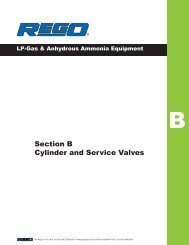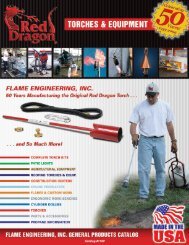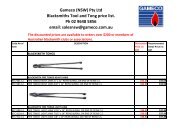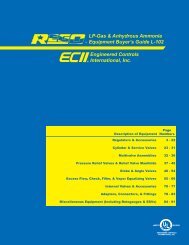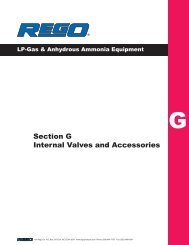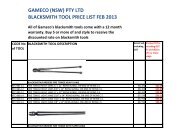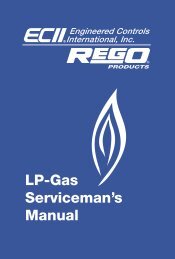Repair Kits Available By Part Number Section 2 Page - GAMECO
Repair Kits Available By Part Number Section 2 Page - GAMECO
Repair Kits Available By Part Number Section 2 Page - GAMECO
You also want an ePaper? Increase the reach of your titles
YUMPU automatically turns print PDFs into web optimized ePapers that Google loves.
VALVE REASSEMBLY<br />
NOTE: Clean all parts prior to reassembly. When lubrication is required,<br />
use compound 11550-215 found in the enclosed kit, number 5555GP<br />
(hydrolith grease). Apply all lubricant as a thin film.<br />
Roller Actuator Subassembly<br />
1. Lubricate the roller pin.<br />
2. Assemble the roller pin into the roller actuator through the roller and<br />
secure with a new cotter pin.<br />
3. Set assembly aside.<br />
Seal Gland / Stem Subassembly<br />
1. Lubricate new outer stem bearing and new stem o-ring and assemble<br />
into seal gland.<br />
2. Lubricate new dirt seal and press fit in place into seal gland.<br />
3. Lubricate the stem and carefully insert it, tapped end out, through<br />
the seal gland assembly. Do not use excessive force that will cut<br />
the o-ring or dirt seal.<br />
4. Lubricate the three (3) new stem seal rings, new stem jam ring and<br />
stem washer. Assemble these one piece at a time over the stem<br />
and into the seal gland. Be careful not to damage any pieces on<br />
the flat edges of the stem.<br />
5. Set assembly aside.<br />
Disc Holder Subassembly<br />
1. Assemble new main seat disc, poppet and seat retainer by re-using<br />
the original seat disc screws. Apply a thin layer of thread locking<br />
compound to the screw threads and torgue to 250-300 in/lbs.<br />
2. Lubricate and install the new stem o-ring into the groove at the base<br />
of the upper stem threads. Slide a new molded stem seal onto the<br />
upper stem. Place the excess flow spring and poppet back over<br />
the lubricated lower stem and slide the poppet over the lower stem<br />
until the wrench flats of the lower stem are exposed. Using a screw<br />
driver and crescent wrench, assemble the upper and lower stem<br />
halves together. Use a thin film of thread locking compound on the<br />
stem threads making sure that the threads are not contaminated<br />
with grease.<br />
3. Slide the stem/poppet assembly into the valve body.<br />
Stem / Actuator Assembly<br />
1. Lubricate new inner stem bearing and new poppet bearing. Install<br />
in valve body.<br />
2. Install seal gland spring and new seal gland gasket into valve<br />
body.<br />
3. Lubricate threads of seal gland. Carefully install the seal gland/stem<br />
sub-assembly into the valve body and through the inner stem bearing,<br />
engaging the seal gland gasket. Torque the seal gland down<br />
to 800-1000 in/lbs.<br />
4. Lubricate the face of the roller actuator assembly.<br />
5. Assemble the lockwasher and jam nut onto the threaded end of<br />
the jam pin. Do not run the nut up the thread at this point.<br />
6. Lubricate the jam pin and slide it up into the roller actuator assembly.<br />
Orient flat of jam pin with bore of roller actuator. While pushing<br />
up on the jam pin, assemble the roller actuator assembly onto the<br />
stem on the inside of the valve body. Align the flat of the jam pin<br />
with the flat of the stem. The jam pin will drop down when properly<br />
aligned. Once aligned, torque the jam nut down to 160-180 in/lbs.<br />
Secure with a new cotter pin.<br />
7. Check to see that the stem rotates smoothly by turning the roller<br />
actuator.<br />
Bonnet Assembly<br />
1. Place the return spring over the stem seat.<br />
2. Place the bonnet over the stem and compress the return spring<br />
until the bonnet is flush with the valve body. Install two (2) bonnet<br />
screws finger tight at locations opposite of each other. DO NOT<br />
RELEASE THE BONNET UNLESS IT IS FLUSH WITH THE VALVE<br />
BODY AND HELD IN PLACE BY AT LEAST 2 SCREWS THAT ARE<br />
OPPOSITE OF EACH OTHER. Install the remaining six (6) screws<br />
and torgue all eight (8) screws to 115-130 in/lbs.<br />
3. Place the strainer back on the valve. Place the strainer top over the<br />
strainer and secure with the two strainer screws with 50-60 in/lbs<br />
of torque<br />
4. Assemble the new upper flange seal gasket and new lower flange<br />
seal gasket to the valve body. This should be done just prior to the<br />
valve installation.Torque down to 115-130 in/lbs.<br />
MANUAL / PNEUMATIC ACTUATOR REASSEMBLY<br />
Manual Actuator Assembly<br />
1. Lubricate the pivot pin. Assemble the channel to the release lever<br />
by pushing the pivot pin up through both pieces and placing the<br />
washer between the top of the channel and release lever. Hold the<br />
pivot pin hex and torque down the new pivot pin locknut to 115-130<br />
in/lbs. Be sure the release lever pivots freely.<br />
2. Assemble the collar washer and collar onto the end of the stem.<br />
3. Assemble the channel spacer/release lever assembly onto the valve<br />
body with the two (2) channel screws and two (2) lockwashers.<br />
Torque down to 250-280 in/lbs. Align parallel to edges of the valve<br />
body face before torquing down. Lever movement should not hit<br />
the collar on the stem.<br />
4. Install the new lever release spring in the recesses between the<br />
valve body and release lever.<br />
5. If a new fuse assembly is necessary, order part number A3219-35.<br />
Torque it down to 240-300 in/lbs. into the channel spacer.<br />
6. Install new bumper and new stop screw into the handle. Torque<br />
the stop screw down to 250-280 in/lbs.<br />
7. Assemble the lockwasher and jam nut onto the threaded end of<br />
the jam pin. Do not run the nut up the thread at this point.<br />
8. Lubricate the jam pin and slide it up into the handle. Orient flat<br />
of jam pin with bore of handle. While pushing up on the jam pin,<br />
assemble the handle onto the stem. Align the flat of the jam pin<br />
with the flat of the stem. The jam pin will drop down when properly<br />
aligned. Once aligned, torque the jam nut down to 160-180 in/lbs.<br />
Secure with a new cotter pin.<br />
Pneumatic Actuator Assembly<br />
1. Attach the bracket with actuator to the valve body with the two (2)<br />
bracket screws and lockwashers. Torque down to 250 in/lbs.<br />
2. Assemble the collar washer and collar onto the stem.<br />
3. Lubricate the jam pin and all the openings in the crank arm. Assemble<br />
the jam pin into the crank arm, small end to the top, and<br />
align so that the 5 /8" diameter crank arm hole is unobstructed.<br />
4. Assemble crank arm onto the valve stem and rotate it clockwise so<br />
that the crank arm leg clears the clevis legs. Push assembly onto<br />
stem until contact is made with the collar. Rotate the crank arm<br />
counterclockwise so the leg positions itself between the legs of the<br />
clevis. Be sure holes are in alignment.<br />
5. Using the end of a pencil or the equivalent, push down on the jam<br />
pin from the top of the crank arm to engage its flat with the valve<br />
stem flat. The jam pin should drop approximately 5 /8". Move or<br />
wriggle the crank arm slightly while pushing down on the jam pin<br />
to help assure proper alignment.<br />
6. Assemble the jam nut fully onto the jam screw. Assemble the jam<br />
screw into the crank arm and torque down to 200 in/lbs. Turn and<br />
torque down the jam nut.<br />
7. Assemble the two pivot pin washers onto the pivot pin. Lubricate<br />
the pivot pin shaft and assemble through the holes of the clevis legs<br />
and crank arm leg. The air chamber shaft can be displaced manually<br />
along with movement of the crank arm to effect alignment. Once<br />
the pivot pin is engaged, check the top surface of the crank arm in<br />
relationship to the top edge of the valve face, or to a horizontal, so<br />
viewed from the end of the valve stem. The crank arm top surface<br />
should be at a slight angle to the left, as if rotated counterclockwise<br />
from the horizontal, approximately two to three degrees. Measure<br />
the clearance between the collar and end of the poppet through<br />
the outlet of the valve. It should measure 3 /32" ± 1 /64".<br />
8. Assemble the cotter pin into the pivot pin hole. Spread and turn<br />
back the cotter pin legs around the pivot pin shaft.<br />
9. Bench test the actuating mechanism by applying 0 to 35 psig air<br />
pressure to the actuator two or three times while checking for binding<br />
or interference. Be sure it operates smoothly and freely.<br />
Test Procedures<br />
1. Open and close the valve three or four times. Check for smooth<br />
operation and proper opening and closing of the main seat (1 1 /8"<br />
nominal opening). See caution note in test #2.<br />
2. If the manual actuator is used, the release lever should snap back



